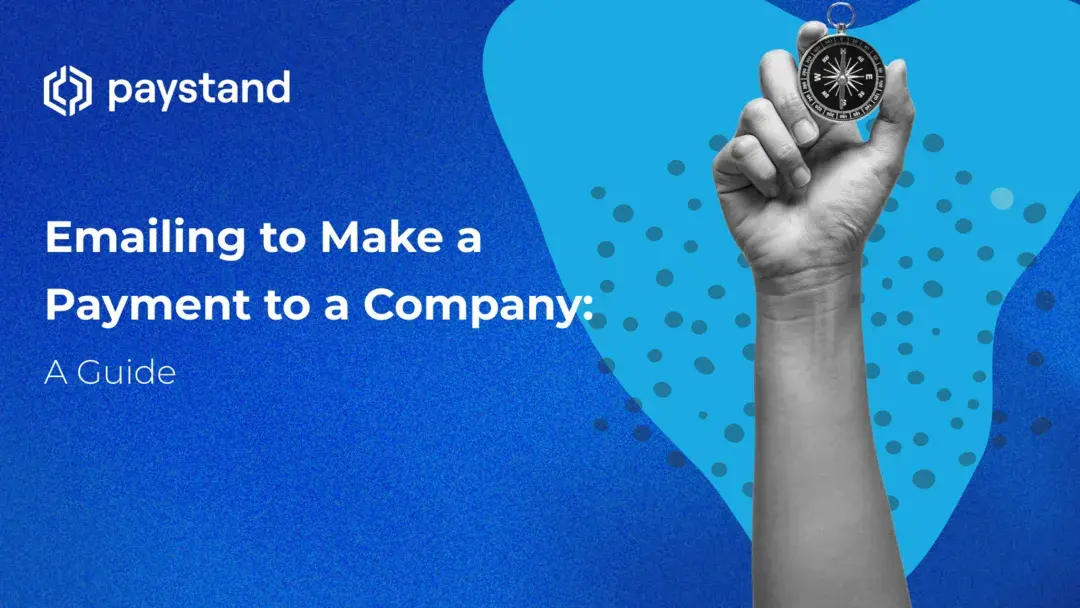Emailing to Make a Payment to a Company: A Guide

Table of Contents
- The importance of clear payment emails
- How to ask for payment professionally in email
- How to write an invoice email
- Payment reminder emails vs. dunning letters
- Tips for writing payment reminder emails
- Using Paystand to streamline payment requests
Key Takeaways
- Payment emails minimize delays, boost collections, and strengthen client relationships by fostering trust and clarity—ultimately offering a competitive edge.
- Professional payment requests require clear subject lines, a respectful tone, and detailed instructions.
- Payment reminders are polite and proactive while dunning letters are formal and emphasize urgency.
- Effective payment reminders use polite language, specific payment details, clear payment options, and strategic follow-up timing.
- Automated payment solutions like Paystand reduce manual work, accelerate collections, and offer real-time payment tracking. These solutions help businesses maintain healthy cash flow and improve financial operations.
Precision, trust, and timely communication drive successful B2B payments. Yet, even the best payment processes can break down when reminders or dunning letters are unclear or poorly crafted. Missteps in tone or vague instructions can lead to delayed transactions, strained relationships, and missed revenue. Clear, courteous payment emails speed up collections and reinforce your reputation as a reliable partner.
Well-structured communication is more than a courtesy—it’s a competitive advantage that directly influences your bottom line.
From writing professional invoice emails to understanding the critical differences between payment reminders and dunning letters, this guide offers actionable tips and real-world examples to elevate your collections strategy. Want to master the art of effective payment requests? Discover how polished emails and strategically crafted reminders can minimize friction, reduce follow-ups, and improve cash flow.
The Importance of Clear Payment Emails
A well-crafted payment email eliminates confusion, clearly communicates payment details, and prevents delays. Effective payment communication is as important as negotiating terms or delivering services in business. Poorly worded or overly aggressive requests can damage trust, while unclear instructions can lead to missed payments or processing errors. A well-structured email shows professionalism and fosters positive client interactions by respecting time and obligations.
Clear emails are especially important when managing large accounts or multiple clients. They prevent misunderstandings about due dates, amounts, or payment methods. Additionally, a carefully crafted message helps reduce the need for repetitive follow-ups and ensures a smoother collections process.
The Profit Paradigm Podcast
We're flipping the script on finance. No fees. No friction. Just pure cash-flow power. If you're ready to automate, accelerate, and take control of your revenue, this is where the future of money movement begins.
How to Ask for Payment Professionally in Email
A professional payment request involves thoughtful phrasing, clarity, and a respectful tone. Start with an engaging subject line that immediately conveys the purpose of your email while remaining polite. For example:
- “Invoice #XXXXX – Friendly Reminder”
- “Follow-Up: Payment for Invoice #XXXXX Due”
A well-chosen subject line reduces the risk of your email being ignored or overlooked.
In your opening line, establish a polite tone. For example:
- “I hope this message finds you well.”
- “We appreciate your business and are following up on an outstanding invoice.”
Next, provide clear payment details. Include the invoice number, amount, due date, and payment instructions. Direct clients to any payment links or portals where they can quickly complete the transaction. Here’s an example:
“Please note that Invoice #XXXXX, dated [Insert Date], with a total amount of [Insert Amount], is due on [Insert Due Date]. You can pay using the secure link below: [Insert Link].”
Finally, include a polite closing and offer assistance if needed:
“Thank you for your prompt attention. Please reach out if you have any questions or require additional information.”
This structured approach maintains professionalism while communicating your payment expectations.
How to Write an Invoice Email
Invoice emails combine documentation with a payment request, making them critical for timely collections. A well-constructed invoice email should balance professionalism, clarity, and a call to action. Here’s a breakdown of key elements:
-
Subject line: Clearly reference the invoice.
- Example: “Invoice #XXXXX – Payment Due by [Insert Date]”
-
Greeting and opening: Use a professional greeting.
- “Dear [Client’s Name], I hope you’re well. Attached is Invoice #XXXXX for [Insert Description], with a total of [Insert Amount].”
-
Payment instructions: Specify the payment link or method.
- “To complete your payment, please use this secure link: [Insert Payment Link].”
-
Follow-up options: Offer contact details for questions.
- “Feel free to contact us at [Phone Number] with questions or concerns.”
Keeping the message direct and polite increases the likelihood of timely payment while maintaining positive client interactions.
Payment Reminder Emails vs. Dunning Letters
Both payment reminder emails and dunning letters are important in collecting payments, but they differ in tone and timing.
- Payment reminder emails are sent before or shortly after a due date. These messages are friendly and encourage timely payment without assuming delinquency.
- Dunning letters are formal notices sent after a payment is overdue. They emphasize the situation's urgency and may include warnings about potential consequences, such as late fees or service disruptions.
While a gentle payment reminder might say:
“Just a friendly reminder that Invoice #XXXXX is due on [Insert Date]. Please let us know if any issues are processing your payment.”
A dunning letter takes a more serious tone:
“Our records indicate that Invoice #XXXXX remains unpaid. To avoid further action, please remit payment immediately or contact us to discuss your account.”
Both approaches are effective when used appropriately, helping businesses maintain professionalism while reinforcing payment terms.
Tips for Writing Payment Reminder Emails
Crafting effective payment reminder emails involves more than just providing payment details. Consider these best practices:
-
Maintain a polite tone: Avoid sounding confrontational, even if the payment is overdue.
-
Be specific: Clearly reference the invoice number, due amount, and due date.
-
Provide payment options: Include links or instructions for secure payments.
-
Space out follow-ups: Avoid overwhelming clients with excessive reminders; use strategic intervals instead.
For more guidance, Paystand’s detailed article on Payment Reminders offers additional strategies to optimize your approach.
Using Paystand to Streamline Payment Requests
Professional payment emails are a key part of effective financial management. By following best practices and leveraging tools like Paystand’s automated payment platform, businesses can simplify their collections process, enhance cash flow, and strengthen client relationships. Whether you’re sending a polite payment reminder, drafting a formal dunning letter, or creating an invoice email, clarity, respect, and professionalism should always guide your communication.





